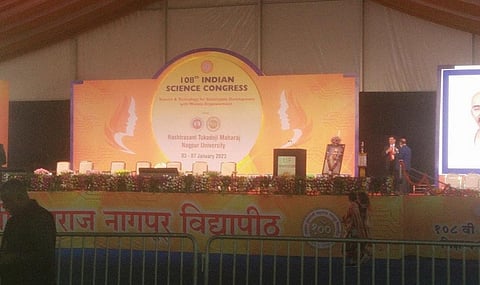

Even as the world is strengthening its ability to catch methane leaks using satellites, India is yet to catch the bus.
However, the Indian Space Research Organisation (ISRO) will be happy to build one if the country considers it, S Somanath, chairman, ISRO and secretary, Department of Space, told Down To Earth during a press briefing at the ongoing Indian Science Congress (ISC) in Nagpur January 4, 2022.
“Methane observation is a major tool to look at global warming. We should advise the scientific community to come forward with such ideas and ISRO will be happy to build it on our own,” Somnath said.
The technology to monitor methane emissions is already there. “We did this on the Mars orbiter (launched in 2013). We have not planned for earth-based observation of methane. However, this is possible,” he added.
Methane, a greenhouse gas, has contributed to about a third of the current anthropogenic greenhouse gas-driven warming, according to an editorial in the journal Nature Geoscience.
More than 50 per cent of global methane emissions can be traced back to human activities such as agriculture, waste and fossil fuel production and consumption.
India is among the top five emitters globally, according to the International Energy Agency.
Shantanu Bhatawdekar, scientific secretary at ISRO, said during an event at the ISC that space provides the best vantage point to observe the Earth in totality.
Monitoring changing greenhouse gas levels is one application of space technology to monitor Earth, he pointed out.
Recently, Methane Alert and Response System (MARS), a new satellite-based system to detect methane emissions, was launched at the 27th Conference of Parties to the United Nations Framework Convention on Climate Change held in Egypt.
MARS will be a part of the United Nations Environment Programme’s International Methane Emissions Observatory strategy.
NASA also uses Earth Surface Mineral Dust Source Investigation (EMIT) and other instruments to track methane emissions.
NASA said October 25 last year that EMIT picked up more than 50 “super-emitters” in central and west Asia and the southwestern United States.
Super-emitters such as facilities, equipment and other infrastructure, typically in the fossil fuel, waste, or agriculture sectors, emit methane at high rates, according to NASA.
The European Space Agency (ESA)’s Sentinel-5P satellite also catches methane leaks. It will be a part of MARS, according to the space agency.
ISRO will have a busy year in 2023. It is expected to launch important missions such as Aditya L1, Chandrayaan 3 and the unmanned Gaganyaan mission.
Aditya L1, like NASA’s Parker Solar Probe and ESA’s Solar Orbiter, will study the sun.
India’s solar probe will continuously observe the sun from Lagrange point L1. According to NASA, Lagrange points are places around a planet where the pull of its gravity, the sun's gravity and the orbit’s motion are balanced.
L1 offers an uninterrupted view of the sun, Anil Bhardwaj, director of the Physical Research Laboratory, said at the event.
L1 receives a constant stream of particles from the sun, the solar wind, about an hour before reaching Earth, ESA noted.
Aditya L1 will study coronal mass ejection, flares and near-earth space weather. It will look at the dynamics of the solar atmosphere and solar wind, Bhardwaj highlighted.
Chandrayaan 3 mission to the Moon is also expected to be launched this year. The mission will aim to land a rover on the lunar body.
Its predecessor, Chandrayaan-2, launched in 2019, failed to make a soft landing. ISRO has addressed shortcomings from the past. “Our goal is to have a safe landing,” Somnath told journalists.
ISRO will also conduct the first launch of the Gaganyaan programme, which aims to demonstrate human spaceflight.
“We are taking a cautious approach,” Somnath said. “We will have an unmanned mission by the end of this year and a manned mission next year,” he added.
The manned mission aims to launch a three-member crew to an orbit of 400 kilometres for three days.
Somnath also stressed that space technology has applications beyond understanding the mysteries of the universe.
It can help understand the Earth better, he said. “Certain observations are not possible when you’re too close. Remote sensing from space can help transform lives,” he added.
Some examples are quantum communication, navigation and communication. We can also study how the sun affects climate and weather and space weather, he pointed out.
ISRO also plans to use satellite for quantum communication, whose applications lies in cryptography, the science of securing private information.
This activity will be a part of the National Quantum Mission, DK Singh, deputy director, Human Spaceflight & Advanced Technology Area, Space Applications Centre, ISRO, told DTE. He was one of the speakers at the event.
“We are enabling it to be space-based,” he said. Satellites make quantum communication feasible. The conventional terrestrial mode of using optical fibres has a range limit of 100-200 kilometres, he pointed out.